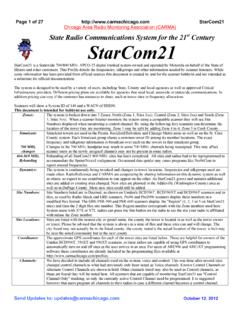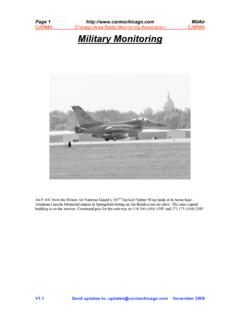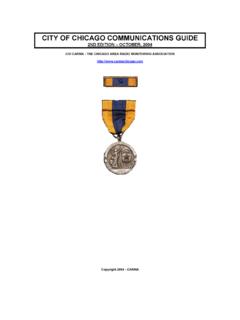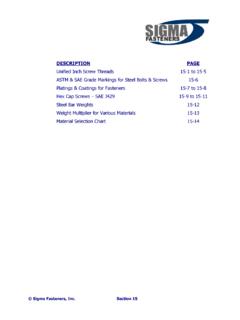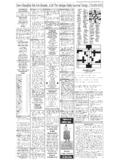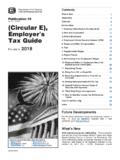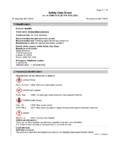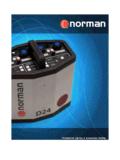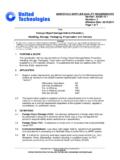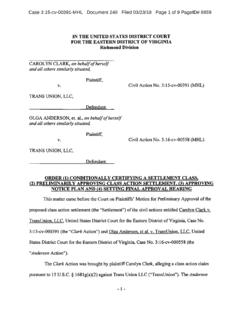Transcription of Page 1 of 15 http://www.carmachicago.com IL …
1 Page 1 of 15 IL railroad radio CARMA chicago area radio monitoring association CARMA CARMA chicago area radio monitoring association CARMA Send updates to: October 2012 Illinois railroad radio Guide With chicago and Illinois being the railroad center of North America the rail frequencies are buzzing constantly. All 6 major railroads of the US and Canada come to chicago and there are numerous regional and shortlines throughout the region. The majority of railroad radio traffic that scannists are interested in is concentrated onto a few dozen VHF frequencies between and MHz. These are assigned to railroads nationwide and the assignments are coordinated by the association of American Railroads (AAR), a trade organization. The AAR approves the frequency assignments and forwards applications to the Federal Communications Commission (FCC) for final approval. The AAR has arranged for a standard channel plan to be used on railroad radios so that all the assigned railroad frequencies have channel numbers.
2 These are indicated on standardized railroad radios as xx yy, where xx is the train s Transmit channel and yy is the Base transmit channel (train s receive channel). Since most channels are simplex (both base and mobile on the same frequency) the radio would display something like 7979 ( TX and RX). If the railroad uses duplex, a repeater or PBX system the display might show something like 79 36 ( train TX, train RX). Most railroads have Channel Plans , separate from the AAR channel numbers. Usually Channel 1 is the main Road Channel and subsequent channels may be alternate Road channels, yard channels or other uses. With the many mergers over the last 2 decades large railroads have multiple channel plans for different divisions. For example, the Union Pacific has channel plans for former CNW, DRGW, SP and MKT sections of the railroad in addition to the channel plan for the historic UP and former MP/WP sections.
3 The listings by railroad will show the Channel Plans as known. Uses for the various channels as known are also listed. Some railroads use PL tones on some channels. These are often used for repeater access and police. On former Conrail lines PL tones are used on Defect Detectors as well. Rail channels, like most of the rest of the VHF and UHF ranges, are going narrowband. While most operations will remain on the existing freqs, as they are narrowbanded during 2011 and 2012 the audio may sound slightly lower. Future operations may eventually include digital, rumored to be NexEdge, a narrowband digital format that can not be decoded on current scanners. For more information on Illinois Railroads see the following sites: Other sources of information: Gary Sturm literally wrote the book on railroad scanner listening. See his web page at ~rrradioman/ for a great listing of rail frequencies. If you need to contact a railroad to report a broken gate or other safety issue see for links to the various railroad hotlines.
4 (Accurate as of January 2004) Channel Uses: Road Used as the main communications channel between trains and other trains, line crews, dispatchers and within the train itself. Yard Used within yards for switching. Disp ( Dispatcher ) Used as a separate channel from the Road Channel on some railroads for trains to contact the Dispatcher. This allows the dispatcher to listen only to traffic directed at him and not the routine chatter. MofW ( Maintenance of Way ) Used for work on the tracks. Police Used by the railroad police and special agents. Hump Used in large yards for switching trains over a large hill, using gravity to help sort cars. PBX Basically a tie-in between railroad radios and the telephone network. These are typically not listed in this document, please check other resources. Page 2 of 15 IL railroad radio CARMA chicago area radio monitoring association CARMA CARMA chicago area radio monitoring association CARMA Send updates to: October 2012 Below is a list of the AAR assigned channel numbers These are shown next to the frequencies used in this Profile: 1*# 2# 3# 4# 5# 6# 7 8 9 10 11 12 13 14 15 16 17 18 19 20 21 22 23 24 25 26 27 28 29 30 31 32 33 34 35 36 37 38 39 40 41 42 43 44 45 46 47 48 49 50 51 52 53 54 55 56 57 58 59 60 61 62 63 64 65 66 67 68 69 70 71 72 73 74 75 76 77 78 79 80 81 82 83 84 85 86 87 88 89 90 91 92 93 94 95 96 97 #@ #@ #@& Notes: * Channel 1 is often programmed for local use, on factory delivered radios it is the same as Channel 2.
5 # Channel s 1 thru 6, as well as thru are not railroad allocated in the USA but are often found on railroad radios. @ Factory delivered radios do not normally have these channels programmed but they may be added by software. & was once allocated to railroad use but later changed. The Rock Island railroad was grandfathered in on this channel so was able to retain it s use. It is still used by some successors on former Rock Island trackage, most notably Metra. End of Train Devices ( EOT s ), also known as FRED s (Flashing Rear End Device ) as well as other names, are used to assist the engineer in controlling his train. They transmit a data signal from the rear of the train indicating movement and brake pressure. Some of these devices are also capable of activating a brake application from the rear of the train, helpful on heavy grades. These are called 2-Way EOT s. Most EOT devices use MHz. to send data to the locomotive.
6 2-Way EOT s use to send data from the locomotive to the rear EOT. Some NS EOT s use MHz. These are being replaced by standard UHF units. ATCS (Advanced Train Control System) is a protocol developed by the AAR to assist railroads in controlling signals and trains by radio . It uses several pairs of frequencies to send data back and forth. There are also several similar protocols in use on various frequencies such as ARES and Safetran. To learn more about these systems go to Ch # Mobile Base Ch # Mobile Base 1 4 2 5 3 6 Other Operations: Railroads are also allocated several sets of UHF channels. These are often used for local operations, trucking subsidiaries, mobile relays, remote control, and data. Remote Control Remote Control Page 3 of 15 IL railroad radio CARMA chicago area radio monitoring association CARMA CARMA chicago area radio monitoring association CARMA Send updates to: October 2012 Burlington Northern-Santa Fe (BNSF) A merger of the Burlington Northern and the Atchison, Topeka & Santa Fe railroads formed the BNSF.
7 In the chicago area they have the former BN mainline west from chicago thru Aurora, where it splits, one line going to Rochelle, Savanna and Minneapolis and the other to Galesburg, Burlington and Kansas City. In addition they have the former Santa Fe mainline from chicago to Galesburg and Kansas City. Each of these lines is extremely busy with dozens of freight trains. The BN line also has several Amtrak and dozens of Metra trains. (Former BN Lines) 39 Road 1 Ottumwa Sub, Galesburg to Halpin 54 Road 2 66 Road 3 Aurora Sub, Savanna to LaCrosse, Beardstown Sub, Beardstown to Paducah Brookfield Sub, Maxwell to KC, chicago Sub, Ottumwa Sub, Halpin to Creston 70 Road 4 Aurora Sub, Aurora to Savanna, Hannibal Sub, Burlington to Quincy Centralia, Beardstown. Also Clyde, Naperville yards 76 Road 5 78 Road 6 85 Road 7 Beardstown Sub, Bushnell to Beardstown, Brookfield Sub, Quincy to Maxwell Mendota Sub, Peoria Sub, Yates City Sub, 87 Road 8 Barstow Sub, Hannibal Sub, Quincy to Lindenwood 47 Road 9 Brookfield Sub, Galesburg to Quincy 93 MofW 81 ARES Data (Steward to Savanna) 17 ARES Data (Galena to E.)
8 Dubuque) 40 ARES Data (Graf to LaCrosse WI) 15 Clyde Yard (Cicero) engine house 51 Rochelle, Eola West Yards 17 W. Quincy, Brookfield (MO), Keokuk Yards 77 Eola East Yard (Former ATSF Lines) 36 Road 1 Chillicothe Sub, McCook to Williamsfield, Corwith Mechanical and roundhouse 96 Road 2 55 Road 3 72 Road 4 32 Road 5 30 Road 6 Hurdland to Congo 18 Road, Williamsfield to Fort Madison, Fort Madison to Hurdland 85 Road Chillicothe Sub, Western Av to McCook 60 MofW 59 Yard Corwith Yardmaster, Willow Springs Yard 45 Yard Corwith Yard Ops 48 Yard Willow Springs Yard Page 4 of 15 IL railroad radio CARMA chicago area radio monitoring association CARMA CARMA chicago area radio monitoring association CARMA Send updates to: October 2012 Canadian National The CN has merged with or controlled several railroads in the chicago area . The GTW, DWP and DTI have been controlled by the CN for decades, the IC, WC and EJ&E have been merged in the last few years.
9 Former WC Lines 54 EtE End to End 45 WC1 Dispatcher (East) 85 WC8 Yard operations 10 WC2 Dispatcher (north, shops yard) 07 WC9 Used in yards. 79 WC3 Dispatcher (Waukesha Sub) 57 WC10 Yard operations 15 WC4 Dispatcher (central, north) 31 WC11 Yard operations, WSOR Road 49 WC5 Yard operations 72 WC12 Yard operations 64 WC6 Shops Roundhouse 89 WC13 Yard operations 76 WC7 Yard operations Former Grand Trunk Western Lines 32 GTW1 Road (Elsdon Sub) 28 GTW2 Dispatcher West (Elsdon Sub) 49 GTW3 Dispatcher East 47 GTW4 Yard 56 MofW 42 Police (except chicago ) 53 Police ( chicago ) Former Illinois Central and chicago Central Lines 72 IC1 Dispatcher 54 IC2 End to End 90 IC3 Markham & Glenn Yards 43 IC4 CCP Freeport Sub Road (west of Hawthorn) 13 Road, Joliet Sub chicago to 21st St. 47 Woodcrest Shop & Glenn Yard 93 Glenn and Moyers Intermodal Markham 43 CCP Road and Markham Yard 49 Markham & CN Gateway Intermodal Markham 78 Markham Yard 60 Yard Former Elgin, Joliet & Eastern Runs from Waukegan to Barrington, Joliet and then east into Indiana.
10 54 EtE End to End 16 1 Eastern Subdivision Road 96 2 Middle and Western Subdivisions & Maintenance 10 3 System-wide Dispatch & Kirk Yard switching 41 4 Gary Mill & US Steel works 91 5 Western Subdivision Road Page 5 of 15 IL railroad radio CARMA chicago area radio monitoring association CARMA CARMA chicago area radio monitoring association CARMA Send updates to: October 2012 The Canadian Pacific has controlled the Soo Line for decades and recently merged the Soo Line into CP Rail. The Soo Line had previously purchased the remains of the Milwaukee Road and sold off the former Soo mainline from Fond Du Lac to chicago to the WC (since purchased by the CN). The old Milwaukee Road Kansas City line to Big Timber was purchased by Metra and west of Big Timber it is owned by the IC&E, this is now part of the CP family again. Metra owns the former Milwaukee Road mainline from chicago to Rondout (near Lake Bluff) and the Fox Lake line.
